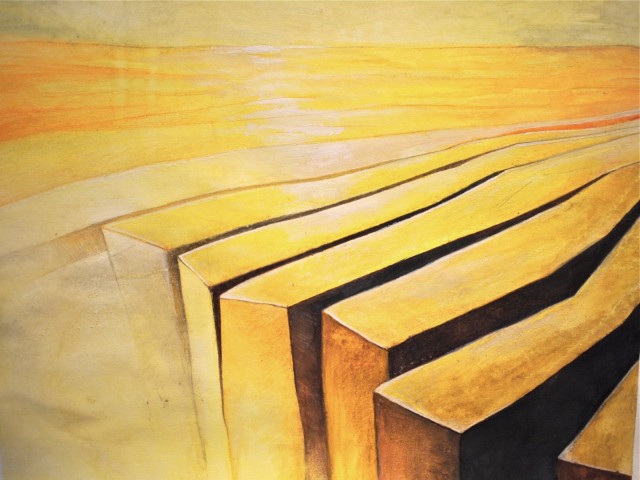Yes, I create digital music, too. One of the things I’ve loved about CDM is the chance to share music making, from the construction of the tools to the production of performances and recordings. If that’s all we ever get out of music – getting to share with someone else – that’s already more than enough for me.
This week I’ve released my own End of Train Device, a full-length ambient / leftfield electronic album.
You can listen to the record in its entirety streaming on SoundCloud, on a site I built using their Premiere App for the Web. (HTML5 + Flash, so it works on computers, tablets, iOS, etc. I’m going to write up a little more documentation on how to use this yourself later this week, in case the included documentation in their code isn’t entirely clear! It’s the same app that Amon Tobin and NinjaTune just used for ISAM.)
It’s also available to stream, share, or as a name-your-own-price, Creative Commons-licensed download on Bandcamp.
I wouldn’t be a writer if I weren’t also a practitioner, so I’m glad any time I can finish this sort of project. At the same time, it’s been a chance for me to reflect on why albums matter to me as a listener – and this release is already a jumping-off point to get to do some research about distribution outlets for independent labels and artists online.
Artwork. The cover images and visual design are the work of Richard Bailey, known as a music artist by the name Proem. Richard also created the code and CSS for CDM’s 2010 redesign. (He released his own new record on n5md last August.)
What I actually use. I don’t use every single tool I test and review in my work; I’d go crazy if I tried. This record was produced largely in Ableton Live. Almost each piece began as a live performance set, and then was reworked into a finished composition later. I tend to start by building up a palette from scratch, working with found sound, synthesis, the piano/keyboard, or some combination. Then I try to construct performance instruments I can play live – Kore, Reaktor, and Live Drum Racks variously feature heavily in these tracks. It’s various live performances that get reworked into a composition. This release represents about four years of work, total, including a great time spent with a group residing with artist Duncan Laurie at his studio. (His electronic contraptions, which I got to play with with Richard Devine, feature alongside sounds of Vidvox developer David Lublin making stew in “Oscilloclast.”)
I didn’t mix in Live, though only because I needed to switch environments to regain some perspective. Half the tracks were finished in Harrison Mixbus; the other half in Propellerhead Record. I’m not as plug-in-happy as I probably sound; most of what you hear is done primarily with my favorite Audio Damage plug-ins and some Propellerhead goodness, along with a lot of sample manipulation.
So, there you go, for everyone who’s been asking me that question for the past years, I’m finally `fessing up and answering.
Mastering. I’m incredibly indebted to my mastering engineer and friend Danny Wyatt (faculty at Dubspot). He worked with Steinberg WaveLab, iZotope Ozone 4, and URS to finish things off.
Me… My background is in classical composition and piano, so that probably … explains a few things.
The experiment(s). Now that this is out, it’s a chance for me to test-drive a lot of the tools for self-releasing music in their present state. I’m hardly the first to write about experiences as an independent artist. Everyone from Brad Sucks to Trent Reznor has weighed in. Digital Audio Insider is a great current read from indie artist David Harrell of the Layaways. Mostly, I get to benefit from the research everyone else is doing.
I very much want to see these models work as a listener, maybe even more than I do as an artist. I can always account for my own musical output – I’ll make music, regardless. But if there aren’t successful tools for other people to use, then I can’t count on other people continuing to release their work, which means I won’t have access to it. Some of my favorite music of 2011 has already been without a label attached; I’ve probably spent more money on Bandcamp than any other service.
Since a lot of writing has been industry-centric, I’m happy for any excuse to cover this exclusively from the perspective of an artist.
We kicked off queries about some of these questions with CDM reader Tricil, who built the Amon Tobin SoundCloud site, by the way – he’s a consultant/designer as well as musician.
Tricil Measures Topspin: One Solo Artist on Making it Online, Comparing Bandcamp
Tricil has already assisted as I’ve begun researching the state of current services. I’ll be testing the ones that look the most promising. I’ll be talking in coming days about how to make SoundCloud, Bandcamp, and Topspin work if you’re an indie artist or label, as well as some reflections on pricing and distribution models for services like TuneCore.
A preview: Bandcamp recently allowed the ability to acquire free music by leaving your email address. It works just as brilliantly as Bandcamp’s purchasing features. But as you’ll see below, what it doesn’t do is pull email addresses directly from the embed – the thing that’s been Topspin’s signature feature.
I hope you enjoy my music; any chance to share it is something I appreciate. I hope you’ll continue sharing yours, and in the words of the old Sesame Street song, that you “don’t worry if it’s not good enough for anyone else to hear.” At the same time, stay tuned for some follow-up about what works, what doesn’t, and what’s worth your time. After all, tearing technology apart to see how it works is part of the mission here.
